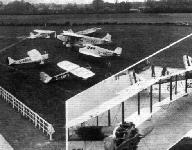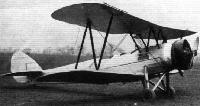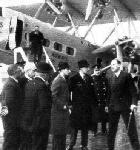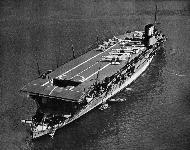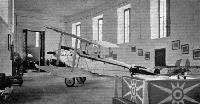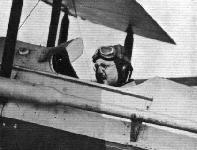Фотографии
-
Регистрационный номер: K1996 DE LUXE TRAINING: The Hawker "Hart Trainer" (Rolls-Royce "Kestrel" engine) is the most recent addition to the series of training aircraft.
Самолёты на фотографии: Hawker Hart - Великобритания - 1928
-
A FORMATION OF AIRCRAFT TYPES USED FOR INSTRUCTION AT THE CENTRAL FLYING SCHOOL: From left to right, Gamecock, Atlas, Moth, III.F, Avro-Lynx, Siskin and Bulldog.
Самолёты на фотографии: Armstrong Whitworth Atlas / Ajax - Великобритания - 1925Armstrong Whitworth Siskin - Великобритания - 1921Avro Avro 504N - Великобритания - 1920Bristol Bulldog - Великобритания - 1927De Havilland Gipsy Moth / Moth X - Великобритания - 1928Fairey Fairey IIIF - Великобритания - 1926Gloster Gamecock - Великобритания - 1925
-
Регистрационный номер: G-ABDC, G-ABDH, G-ABEF, G-ABFV, G-ABGK, G-ABLI, NC9678, VH-UDY SCENES AT HESTON: Some of the commercial aircraft which were on view - ABGK, Lockheed "Vega"; ABLI, Spartan Mailplane; ABEF, Ford; ABDC, Junkers; ABDH and ABFV, "Puss Moths."
Самолёты на фотографии: De Havilland Puss Moth / D.H.80 - Великобритания - 1929Ford Tri-Motor / 4-AT / 5-AT - США - 1926Junkers F 13 - Германия - 1919Lockheed Vega - США - 1927Spartan Cruiser - Великобритания - 1932
-
Flt. Lt. D. V. Ivins boarding his privately-owned Bristol Fighter (Hispano).
Самолёты на фотографии: Bristol F.2A/F.2B Fighter - Великобритания - 1916
-
Регистрационный номер: D-1929 THE ATLANTIC CIRCUMNAVIGATED: Two views of the Dornier Do.X moored off Calshot. These pictures give a good idea of the height of the propellers above the water line, where they are well protected against spray. The use of the lower wing stumps as boarding platforms is also well brought out.
Самолёты на фотографии: Dornier Do.X - Германия - 1929
-
AN EARLY "PUSHER": One of the Bristol "Box Kites" with Gnome rotary engine, on which many early pilots were trained.
Самолёты на фотографии: Bristol Boxkite - Великобритания - 1910
-
The start of the first heat for the Race at Skegness: (Left to right) "Avian," "Cadet," "Avian," "Spartan," "Widgeon" and Autogiro - the last, in its first race.
Самолёты на фотографии: Avro Avian / Type 594/616 - Великобритания - 1926Avro Cadet / Type 631/643 - Великобритания - 1932Cierva/Avro C.19 - Великобритания - 1929Simmonds Spartan - Великобритания - 1928Westland Widgeon - Великобритания - 1924
-
Регистрационный номер: NR965Y, NC965Y "LADY LINDY'S" LOCKHEED: Miss Earhart's Lockheed "Vega" monoplane in the field outside Londonderry, after the Atlantic crossing.
Самолёты на фотографии: Lockheed Vega - США - 1927
-
Регистрационный номер: CH-168 [2] The Lockheed "Orion" used by Swissair on its high-speed services.
Самолёты на фотографии: Lockheed Orion 9 - США - 1931
-
Регистрационный номер: CH-168 [2] WITH UNDERCARRIAGE RETRACTED: One of the Lockheed "Orions" of the "Swissair" company as it appears in flight.
Самолёты на фотографии: Lockheed Orion 9 - США - 1931
-
The flight of "Wapitis" from 601 City of London (Bombing) Squadron, A.A.F.
Самолёты на фотографии: Westland Wapiti - Великобритания - 1927
-
Handing up a camera to the observer.
Самолёты на фотографии: Fairey Gordon / Seal - Великобритания - 1931
-
Squadron "V": A fine piece of formation flying by No. 40 (Bomber) Squadron.
Самолёты на фотографии: Fairey Gordon / Seal - Великобритания - 1931
-
Line Abreast: Among the clouds on a stormy day.
Самолёты на фотографии: Fairey Gordon / Seal - Великобритания - 1931
-
"Squadron, Right wheel": No. 40 (Bomber) Squadron in squadron formation.
Самолёты на фотографии: Fairey Gordon / Seal - Великобритания - 1931
-
Pilots of No. 40 B.S. (left to right): Sgts. Emly, Harris, Pattenden, Sowden, Evans; F/O. D. G. Morris; Flt. Lts. J. E. L. Drabble, C. C. Edwards, R. J. H. Holland; (behind) F/O. N. C. M. Styche; Sqd. Ldr. M. L. Taylor, A.F.C.; (behind) P/O. O. P. E. Williams; F/O. H. V. L'Amy; P/O. A. Taylor; F/O's. H. P. Wilson, G. Calvert; Sgt. Christian; P. O. G. W. Montagu; Sgt. O'Brien; P/O. R. H. Page; Sgt. Avent; F/O. L. F. H. Orr; P/O. W. H. N. Turner.
Самолёты на фотографии: Fairey Gordon / Seal - Великобритания - 1931
-
The Airmen of No. 40 (Bomber) Squadron.
Самолёты на фотографии: Fairey Gordon / Seal - Великобритания - 1931
-
Регистрационный номер: K1743 Line up of the 12 "Gordons" of No. 40 (Bomber) Squadron at Upper Heyford.
Самолёты на фотографии: Fairey Gordon / Seal - Великобритания - 1931
-
BRITISH AIRCRAFT IN SPAIN: As previously reported in "Flight," a Vickers "Vildebeest" torpedo carrier was recently delivered to the Spanish Government at Madrid - the first of an order of 26 machines. Our picture shows the machine at Madrid, when a successful demonstration was carried out by Mr. H. W. R. Banting.
Самолёты на фотографии: Vickers Vildebeest / Type 132 - Великобритания - 1928
-
A MODERN TRAINING MACHINE: The Avro "Tutor," or 621, with Armstrong-Siddeley "Lynx" engine, is a worthy successor of the 504.
Самолёты на фотографии: Avro Tutor/Sea Tutor/Prefect / Type 621/646/626 - Великобритания - 1929
-
Регистрационный номер: G-ABPH HANGING ON THE ANTI-LIFT WIRES: Captain Hubert Broad doing inverted flying on one of the new "Tiger Moths." The first of a batch of these machines have already been delivered to the R.A.F. Flying Training School at Grantham.
Самолёты на фотографии: De Havilland Tiger Moth / D.H.82 - Великобритания - 1931
-
A view of the new Avro "Cadet" which Mr. H. A. Brown threw about in an amazing manner. Six of these aircraft have been delivered to the Irish Free State for training.
Самолёты на фотографии: Avro Cadet / Type 631/643 - Великобритания - 1932
-
Регистрационный номер: G-AAXD SAFETY IN THE AIR: His Royal Highness the Duke of York inspected the aerodrome building at Croydon, and the Handley Page "Horatius," on the occasion of the Inauguration of the Air Safety Section of the National Safety First Association on May 5.
Самолёты на фотографии: Handley Page H.P.42 / H.P.45 - Великобритания - 1930
-
The Annual Display of the Scottish Flying Club was held at Moorpark Aerodrome, Renfrew, on May 21, 22 and 23 in "some" rain. "Heracles," the Imperial Airways H.P.42, flew up so that visitors were able to have joy rides in a modern large aircraft. On Saturday there was a display by No. 602 (City of Glasgow) (Bomber) Squadron, A.A.F., in their Westland "Wapitis."
Самолёты на фотографии: Handley Page H.P.42 / H.P.45 - Великобритания - 1930
-
The winner's "Puss Moth" (Gipsy III) arrives in the rain at Heston.
Самолёты на фотографии: De Havilland Puss Moth / D.H.80 - Великобритания - 1929
-
Регистрационный номер: G-AAXX WITH THE POWERS OF NEMESIS: Capt. A. G. Lamplugh, Underwriter and Principal Surveyor of the British Aviation Insurance Co., Ltd., is here seen at Heston with his company's "Puss Moth." Everyone was glad to see him walking about again after his accident. He looked very fit, although it will be seen that hoped that he still has to rely on a strut for his "undercarriage."
Самолёты на фотографии: De Havilland Puss Moth / D.H.80 - Великобритания - 1929
-
Регистрационный номер: S1263 THE FIFTH AND LATEST: The Blackburn Iris "family" has reached its fifth descendant with the "Iris V" shown here in flight. This is by far the most powerful of these Blackburn boats, being driven by three Rolls-Royce "Buzzard" engines of more than 800 h.p. each. As a result of the extra power the performance is greatly improved, and the machine will maintain flight with any one of the three engines stopped.
Самолёты на фотографии: Blackburn Iris / R.B.1 - Великобритания - 1926
-
H.E. The Viceroy and Lady Willingdon arrived by aeroplane at Peshawar on the 16th April, to install the new Governor of Province (Sir Ralph Griffiths), and to inaugurate the new Legislative Council. In the photo are seen Lord Willingdon, shaking hands with Lady Griffiths. Lady Willingdon has just descended from the Avro 10 and is going to shake hands with Sir Ralph Griffiths (Chief Commissioner of the North-West Frontier Province and Governor Designate).
Самолёты на фотографии: Avro Ten / Type 618 - Великобритания - 1928
-
THE MAKHONINE MONOPLANE: View of the machine with wings extended, as for takeoff and landing.
Самолёты на фотографии: Makhonine Mak.10 / Mak.101 / Mak.123 - Франция - 1931
-
THE MAKHONINE VARIABLE AREA MONOPLANE: This view shows the wing area reduced almost to its minimum, as it would be in the high-speed condition.
Самолёты на фотографии: Makhonine Mak.10 / Mak.101 / Mak.123 - Франция - 1931
-
THE MAKHONINE WING: This sketch is purely diagrammatic, in order to show the principle, and does not correspond closely with the actual wing.
Самолёты на фотографии: Makhonine Mak.10 / Mak.101 / Mak.123 - Франция - 1931
-
THE "FLYING CARPET": Richard Halliburton and Moye Stephens, who are on a World Tour, flying over the Taj Mahal.
Самолёты на фотографии: Stearman C1 / C2 / C3 / 4E / 6 Cloudboy - США - 1927
-
Регистрационный номер: G-ABLM American interest in the cabin Autogiro at Hanworth: (Left to right) - Larsen, H. Pitcairn, A/M. J. G. Weir, Senor de la Cierva, T. Ray, R. A. C. Brie.
Самолёты на фотографии: Cierva/De Havilland C.24 - Великобритания - 1931
-
Регистрационный номер: G-ABBN AERODROME RACING: Realising the fascination of watching aeroplanes racing around a course on the aerodrome, Sir Alan Cobham has included this item in his programme. Here are seen a Southern "Martlet" and a Comper "Swift" fighting for first place.
Самолёты на фотографии: Comper Swift / CLA.7 - Великобритания - 1930Southern Martlet - Великобритания - 1929
-
THE HORNET'S NEST: AN AERIAL VIEW OF THE AIRCRAFT CARRIER "COURAGEOUS." THE MACHINES RANGED ON THE FLYING DECK INCLUDE FAIREY "FLYCATCHERS" AND IIIF'S. NOTE THAT BOTH LIFTS ARE DOWN, PRESUMABLY TO FETCH MORE AIRCRAFT.
Самолёты на фотографии: Fairey Fairey IIIF - Великобритания - 1926Fairey Flycatcher - Великобритания - 1922
-
Самолёты на фотографии: Curtiss F9C Sparrowhawk - США - 1931
-
SARO "CUTTY SARKS" FOR CHINA: Two of these machines were shipped recently. They are fitted with two Armstrong-Siddeley "Genet Major" 7-cylinder engines, which give a materially improved performance; extra fuel tanks have been fitted, giving a maximum duration of 7 hours.
Самолёты на фотографии: Saunders-Roe Cutty Sark / A.17 - Великобритания - 1929
-
A NEW SARO "CUTTY SARK": Fitted with a direct-drive Armstrong-Siddeley "Lynx" engine, this machine has been equipped with extra tanks and special instruments, and is being flown by the Japanese pilot Yoshihara from San Francisco to Japan - as previously reported in "Flight."
Самолёты на фотографии: Saunders-Roe Cutty Sark / A.17 - Великобритания - 1929
-
Регистрационный номер: D-1169 A FOREIGN VISITOR: The Raab-Katzenstein (Siemens) which Herr Max Behland has brought over to Heston. It is understood that he will be giving some acrobatic displays, a form of flying at which he is particularly experienced.
Самолёты на фотографии: Raab-Katzenstein RK.1 Schwalbe / RK.2 Pelikan / RK.9 Grasmucke - Германия - 1926
-
Регистрационный номер: J9777 FITTED FOR "BLIND" FLYING: The Hawker "Tomtit" (Armstrong-Siddeley "Mongoose" engine) has a hood over the rear cockpit, used for teaching flying entirely by instruments.
Самолёты на фотографии: Hawker Tomtit - Великобритания - 1928
-
Регистрационный номер: G-AALL The "scratch" man, F/O. E. C. T. Edwards, taking-off on his Hawker "Tomtit" (Mongoose III).
Самолёты на фотографии: Hawker Tomtit - Великобритания - 1928
-
Регистрационный номер: OH-ABB FROM FINLAND TO THE CAPE IN A JUNKERS "JUNIOR": As previously recorded in "Flight," Capt. V. E. Bremer, the Finnish airman, recently flew from Finland to Capetown in a Junkers "Junior" (Armstrong-Siddeley "Genet"). Our picture shows Capt. Bremer with his machine about to leave Helsingfors - actually, he flew the "Junior" and did not haul in as shown! During this trip he made two fine non-stop flights, from Naples to Tunis, across the Mediterranean, and from Cairo to Wadi Haifa - a distance of 750 miles in 7 hours.
Самолёты на фотографии: Junkers A 50 Junior - Германия - 1929
-
Регистрационный номер: G-AAJY [6] Самолёты на фотографии: Short Valetta / S.11 - Великобритания - 1930
-
Регистрационный номер: G-AAJY [6] Самолёты на фотографии: Short Valetta / S.11 - Великобритания - 1930
-
Регистрационный номер: G-AAJY [6] THE "VALETTA" LAND UNDERCARRIAGE: It picks up on three of the four points used in the float undercarriage, the outer rear support being idle.
Самолёты на фотографии: Short Valetta / S.11 - Великобритания - 1930
-
Регистрационный номер: G-AAJY [6] THE TAIL WHEEL: This is of the castoring type, and is centred by the rubber cords.
Самолёты на фотографии: Short Valetta / S.11 - Великобритания - 1930
-
Регистрационный номер: G-AAJY [6] LANDPLANE AND SEAPLANE: The Short "Valetta" (Bristol "Jupiter" engines) has now been fitted with a wheel undercarriage, and has been flown as a landplane. A view of the machine as a seaplane is included for comparison.
Самолёты на фотографии: Short Valetta / S.11 - Великобритания - 1930
-
Регистрационный номер: G-AAJY [6] UNUSUAL BRACING: This front view shows the arrangement of the rigid strut bracing, which distributes landing loads in an unusually complete way.
Самолёты на фотографии: Short Valetta / S.11 - Великобритания - 1930
-
The winning "Spartan" 3-seater landing at Skegness after its excellent race.
Самолёты на фотографии: Simmonds Spartan - Великобритания - 1928
-
AT THE ATHENS AERO SHOW: The de Havilland "Gipsy Moth" which was one of the British exhibits at the recent International Aero Show at Athens.
Самолёты на фотографии: De Havilland Gipsy Moth / Moth X - Великобритания - 1928
-
"Moths" of the Aero Club du Katanga outside the hangars at Elisabethville, in the Belgian Congo.
Самолёты на фотографии: De Havilland Gipsy Moth / Moth X - Великобритания - 1928
-
ENDURANCE: Mr. C. W. A. Scott, who flew from England to Australia in 8 days 20 hr. 47 min. in his "Gipsy Moth."
Самолёты на фотографии: De Havilland Gipsy Moth / Moth X - Великобритания - 1928
-
Mr. J. Grierson, "Moth" (Gipsy I), arrives at Heston, second, in still heavier rain.
Самолёты на фотографии: De Havilland Gipsy Moth / Moth X - Великобритания - 1928
-
Mr. G. Baillie, the third arrival. His "Moth" (Gipsy I) was fitted with a Standard wireless set by means of which he was able to get the weather reports broadcast from Heston during the race.
Самолёты на фотографии: De Havilland Gipsy Moth / Moth X - Великобритания - 1928
-
SOME EARLY AEROPLANES: 3. THE MAURICE FARMAN "SHORTHORN" HAD NO FRONT ELEVATOR. BOTH TYPES WERE FITTED WITH RENAULT ENGINES.
Самолёты на фотографии: Maurice Farman MF.9 - Франция - 1913
-
Самолёты на фотографии: Farman F.250 - Франция - 1931
-
Самолёты на фотографии: Farman F.250 - Франция - 1931
-
Регистрационный номер: F-ALEG THE FARMAN 250: The view shows the clean lines of this new passenger and mai plane.
Самолёты на фотографии: Farman F.250 - Франция - 1931
-
THE SCHMEIDLER VARIABLE WING: Three-quarter rear view of the experimental machine.
Самолёты на фотографии: Schmeidler SN.2 - Германия - 1932
-
THE SCHMEIDLER VARIABLE WING: Diagrammatic Plan View of the arrangement of the wing. The trailing edge is pivoted at the outer end and housed in the main wing.
Самолёты на фотографии: Schmeidler SN.2 - Германия - 1932
-
Diagrammatic representation of the operating mechanism of the Schmeidler variable wing. The camber as well as the area is altered.
Самолёты на фотографии: Schmeidler SN.2 - Германия - 1932
-
Регистрационный номер: CF-ALM [3] Самолёты на фотографии: Curtiss-Reid Courier - Канада - 1932
-
Регистрационный номер: CF-ALM [3] A side view of the Curtiss-Reid "Courier" mail plane, with wings folded.
Самолёты на фотографии: Curtiss-Reid Courier - Канада - 1932
-
Регистрационный номер: CF-ALM [3] Front view of the Curtiss-Reid "Courier" mail plane; it is fitted with an inverted "Gipsy III" engine.
Самолёты на фотографии: Curtiss-Reid Courier - Канада - 1932
-
Curtiss-Reid "Courier" D.H. Gipsy III Engine
Самолёты на фотографии: Curtiss-Reid Courier - Канада - 1932
Статьи
- Flight


